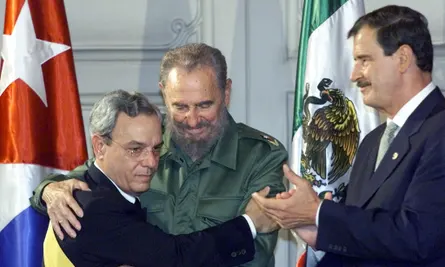Lance Armstrong probably never anticipated that his Livestrong campaign would inspire so many imitators, let alone in Cuba. But on October 29th, 70 young Cuban citizens wearing rubber bracelets imprinted with the word cambio (change) were arrested while protesting recent elections for Cuba’s National Assembly. In the following months, and as recently as January 21, handfuls of others sporting the white armbands have been harassed as well.
Cuban-American political figures have been quick to don the bracelets themselves, in solidarity, they stress, with those on the island who want democracy. Yet for students and teens in Havana, the significance of this piece of casual jewelry may not be so straightforward.
Cambio has certainly been on many Cuban officials’ minds since Fidel Castro transferred powers to his brother fifteen months ago, and even more so as Cuba’s “legislature” prepares to decide whether el comandante will formally reassume Cuba’s presidency. Whatever Fidel’s position, Raul has made it no secret that he will pursue selective, but nonetheless important economic reforms. In a series of neighborhood meetings and other public forums, Cubans have been encouraged to voice their concerns about everything from food shortages to the inadequacy of government salaries.
Ninety miles across the Florida straits, talk of change reflects other concerns. For some, the “embargo” remains a figment of the imagination, riddled with “loop holes” permitting extensive agricultural trade and remittance transfers. Maintaining or even tightening current restrictions, they insist, is the only way to bring the Castro dictatorship to its knees. For anti-embargo activists, on the other hand, the consolidation of Raul’s successor government presents an opportunity to correct a failed U.S. policy that has alienated world opinion and left Washington with little or no leverage in Havana.
Others have pinned their hopes for change to the island’s established opposition movements. If Cuba is ever to be democratic, they argue, greater attention and external support must be provided to those actively and peacefully struggling against the regime.
Sadly, in each of these scenarios, the parameters and agents of “change” have already been defined. Raul Castro has opened limited space for public dialogue on Cuba’s economic policies, but topics such as human rights and broader political reforms remain taboo (although it remains to be seen whether Cuba’s announcement that it will sign the International Covenant on Civil and Political Rights will translate to more open discussion of these issues; I doubt it). Meanwhile, supporters of the embargo ignore the fact that current sanctions are broadly unpopular among the Cuban people, not just because of their economic effects, but because they hand the Cuban government a convenient excuse for its failures. Many pro-embargo activists also advocate a rapid transition to free-market capitalism that would be welcomed by few on the island, especially if it were to threaten the provision of key social services.
The most credible proponents of ending the embargo approach Cuba through a strategic lens and are willing to work with the island’s leaders in the hopes that greater contact will bring democratic dividends in the long run. Such reasoning may have its merits, but it too, pushes the majority of Cuba’s citizens to the sidelines for the foreseeable future.
As for the island’s fragmented opposition groups, not only are they routinely infiltrated by state security, but many Cubans remain sensitive to the possibility that dissidents are beholden to interests in Miami or Washington. Accusations along these lines are broadcast daily across Cuba’s state-controlled media.
Skeptical of government forums, wary of the organized opposition, and overlooked in the U.S. policy debate, most Cubans under 30 are left without sufficient space to define what change – cambio – might really mean for them. Apathy reigns supreme on Havana’s streets as a result.
This is why the cambio bracelet fad is so potentially refreshing. While the harassed students clearly want more of a voice in their government, they are unlikely to share a concrete political platform. Instead, the simple act of wearing the bracelets each day may represent something more transcendent: the desire of Cuban youth to wipe the slate clean, assert ownership over what has become an empty and stale debate, and begin defining for themselves a new vision of the future.
Is this a naïve hope? Probably. But in a country often described as a surreal destination – where doublethink is a national pastime, and where a Revolution has long ceased to be revolutionary – stranger things have been known to happen.

Reply